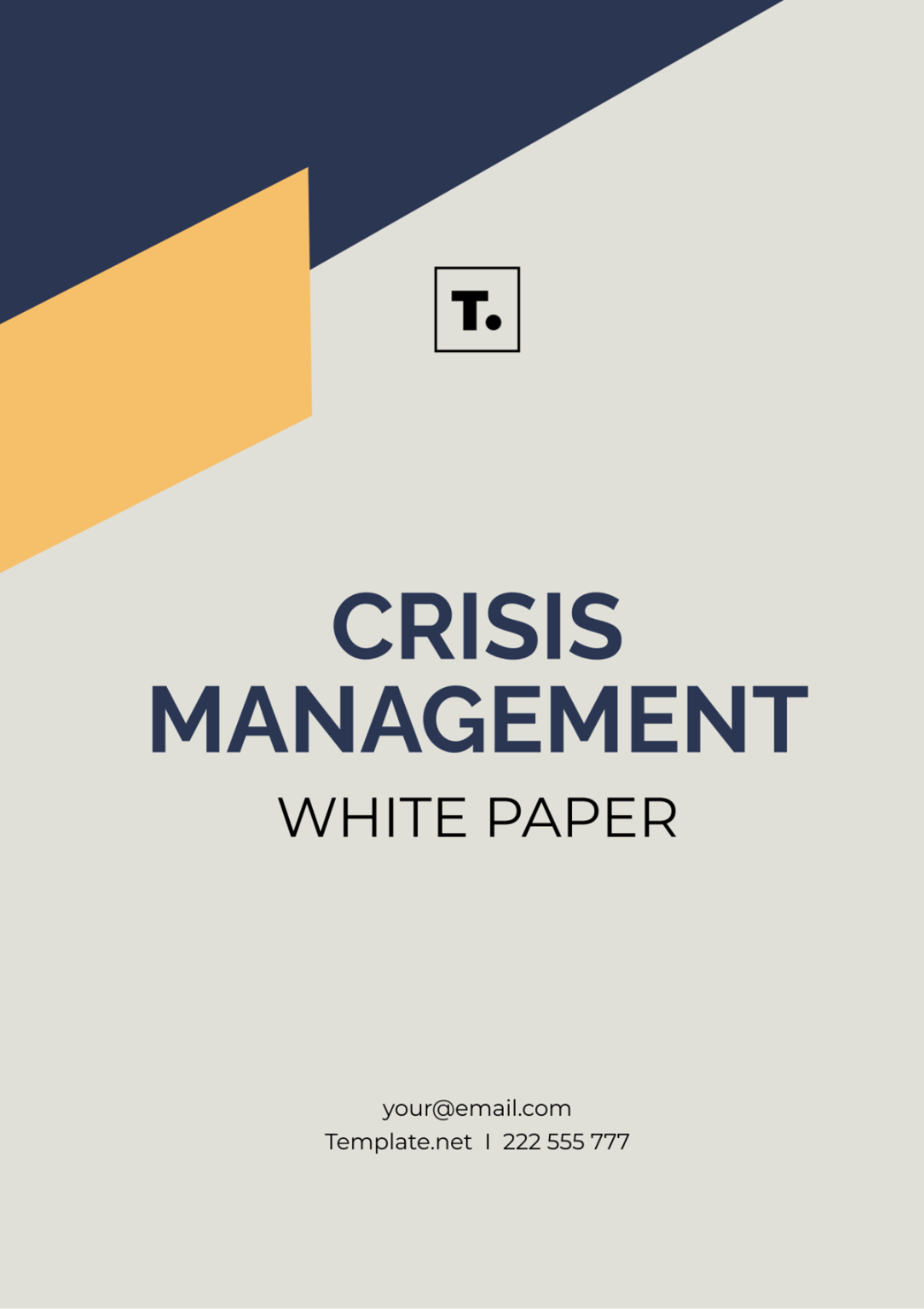Free Crisis Management White Paper

I. Executive Summary

The Executive Summary provides a comprehensive encapsulation of the essence and strategic focus of the Crisis Management Plan.
Purpose: Ensure that systems and strategies are robust and resilient, effectively responding to crises while emphasizing the importance of proactive risk mitigation strategies and the continuous operation of essential functions.
Scope: A addresses crises related to environmental issues, technological problems, organizational challenges, and reputational damage, and is applicable across various organizational levels to ensure coordinated and effective responses.
Key Points: Summarizes crisis management pillars—identification, response strategies, communication plans, recovery, and evaluation—showing their interconnectedness for a robust crisis management framework.
II. Introduction
In our industry, understanding market dynamics, regulations, and competition shapes our crisis management context. Challenges like rapid tech changes, market shifts, and supply chain vulnerabilities highlight the need for proactive planning.
Crisis goals: maintain operations, financial stability, and reputation while prioritizing stakeholders. A structured approach ensures clear roles, efficient communication, and resource optimization, vital for identifying and mitigating risks promptly.
III. Identification of Potential Crises
Environmental Crises: Natural disasters like earthquakes, floods, hurricanes, wildfires, and pandemics disrupt operations, endanger safety, and cause economic losses.
Technological Crises: IT failures, cyber-attacks, data breaches, and system breakdowns lead to data loss, financial theft, operational disruptions, and damage to trust.
Organizational Crises: Internal issues such as leadership disputes, financial mismanagement, accidents, labor strikes, and ethical lapses impact morale, investor confidence, and regulatory compliance.
Reputational Crises: Events like scandals, product failures, ethical lapses, and negative media coverage damage public perception, leading to trust loss, market share decline, and investor concerns.
IV. Crisis Response Strategy

Initial Response
Activate Crisis Team: Immediately assemble the crisis management team comprising key decision-makers from relevant departments.
Assess Situation: Gather information to understand the nature, scope, and potential impact of the crisis on operations, stakeholders, and reputation.
Implement Immediate Actions: Take necessary steps to ensure employee safety, secure critical assets, and initiate preliminary containment measures.
Communication Strategy
Internal Communications:
Designate Spokesperson: Appoint a trained spokesperson to communicate with employees, ensuring consistent and accurate messaging.
Employee Notifications: Disseminate safety instructions, operational updates, and crisis protocols through internal channels promptly.
External Communications:
Media Liaison: Designate a media contact person to handle external inquiries and media relations professionally.
Stakeholder Updates: Communicate transparently with customers, investors, suppliers, and regulatory bodies, providing timely updates and reassurance.
Resource Management
Resource Allocation: Allocate personnel, financial resources, and technology assets based on crisis priorities and response needs.
Utilization Efficiency: Optimize resource utilization by coordinating teams, leveraging existing partnerships, and implementing contingency plans where applicable.
Escalation Procedures
Internal Reporting Structure: Define clear escalation paths within organizational hierarchies for escalating crisis severity or unresolved issues.
Executive Involvement: Specify conditions under which senior management or executive leadership should be informed or directly involved in crisis management decisions.
External Coordination: Establish communication channels with external agencies, authorities, or industry partners for coordinated responses if needed.
V. Communication Plan
Communication Team
Spokesperson: Designate a media-savvy spokesperson for official updates.
Crisis Team: Include PR/communications, legal, operations, and executives.
Support Staff: Assign roles for information gathering, media monitoring, and response drafting.
Stakeholder Identification
Primary Stakeholders: Promptly inform employees, management, customers, and suppliers about relevant information or updates.
Secondary Stakeholders: Take into consideration regulators, media representatives, local governing authorities, and the members of the general public.
Message Development
Clear & Accurate Messaging: Refrain from using technical jargon, ensure that all facts are accurate and verified, demonstrate empathy toward others, and customize your messages to suit the specific audience or individual.
Channels of Communication
Traditional Media: Use press releases, conferences, and interviews.
Digital Platforms: Engage via social media for real-time updates and FAQs.
Internal Communication: Utilize intranet, emails, and meetings for staff.
Direct Outreach: Contact critical stakeholders directly as needed.
Website Updates: Maintain a crisis page with accurate info and contacts.
VI. Recovery and Post-Crisis Evaluation
Recovery Methods
Assessment of Damage: Evaluate crisis impact on operations, finances, reputation, and stakeholder relations.
Prioritize Tasks: Identify critical tasks for swift restoration of normal operations.
Resource Allocation: Allocate personnel, technology, and financial resources effectively.
Stakeholder Communication: Keep stakeholders updated on recovery progress and timelines.
Contingency Plans: Update and implement plans based on recovery lessons.
Post-Crisis Evaluation
Review and Analysis: Assess the crisis management process for strengths and improvement areas.
Lessons Learned: Document key learnings, successes, challenges, and improvement needs.
Recommendations: Develop actionable recommendations for training, tech upgrades, and process refinement.
Plan Updates: Update crisis management plan based on evaluation findings.
Continuous Improvement
Monitoring and Testing: Regularly test protocols, communication channels, and response procedures.
Feedback Mechanisms: Establish feedback channels for insights from stakeholders and teams.
Integration: Align crisis management with overall business strategy, risk management, and compliance frameworks.
VII. Appendix
In this section, we provide essential supporting documents and data to reinforce our crisis management strategies:
Crisis Management Plan: Detailed protocols, procedures, and contact information for swift crisis response.
Contingency Plans: Specific plans for various crises, outlining actions, responsibilities, and escalation procedures.
Communication Templates: Samples for consistent internal and external crisis messaging.
Additional Data and Research:
Crisis Impact Analysis: Lessons learned from past crises on operations, finances, and reputation.
Market and Industry Research: Insights into market dynamics, regulations, and industry standards.
Risk Assessments: Identification of risks, vulnerabilities, and tailored mitigation strategies.
Visual Aids: Organizational Charts, Flowcharts, and Data Visualization for process understanding and improvement.
Regulatory Compliance: Legal documents ensuring adherence to compliance guidelines and industry standards.
- 100% Customizable, free editor
- Access 1 Million+ Templates, photo’s & graphics
- Download or share as a template
- Click and replace photos, graphics, text, backgrounds
- Resize, crop, AI write & more
- Access advanced editor
Craft comprehensive crisis strategies with our editable Crisis Management White Paper Template from Template.net. Customizable to your needs, it's editable in our Ai Editor Tool, ensuring seamless customization and professional presentation for effective crisis management solutions. This template streamlines strategy creation, providing a structured approach to tackle crises with confidence, supported by our user-friendly editing tools.





























